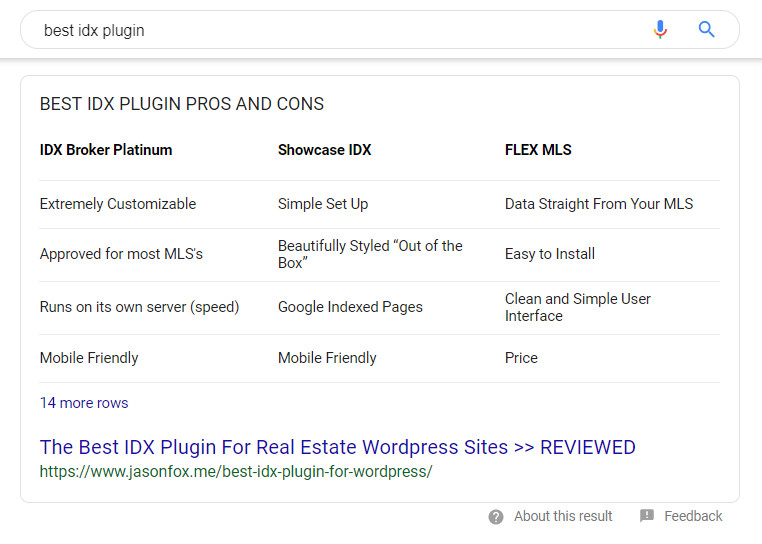Contents
With countless blogs competing for higher rankings, standing out in Google’s search engine results pages (SERPs) can be challenging, especially in the real estate niche. One way to boost your blog’s visibility is by appearing in a featured snippet.
These search components often appear at the top of search results, providing users with quick, concise answers. Gaining this spot can greatly improve your blog’s reach and authority, but it takes several strategies to succeed.

The Rise of Featured Snippets and AI Overviews
Over the years, Google has changed how information appears in search results. Its strategic moves aim to help users find immediate answers more easily. Among these developments are featured snippets.
Featured snippets come in various forms, including lists, tables and paragraphs. These excerpts directly answer the user’s question and position the linked content as the go-to source for information.
On top of this shift is a new feature called AI Overviews. These are synthesized snippets that Google created to provide more relevant answers to complex questions. AI Overviews use artificial intelligence (AI) to generate summaries based on the bot’s interpretation of user queries. Since Google began testing AI Overviews in March 2024, this feature has expanded to all U.S.-based users and will roll out to more countries by the end of the year.
For real estate professionals, these search engine components create many opportunities to increase content discovery.

Why Featured Snippets and AI Overviews Matter for Real Estate Blogs
Securing a featured snippet or spot alongside Google’s AI Overviews offers a strategic advantage. It can significantly boost your blog’s visibility and engagement because users rely on Google for quick answers and concise information. Therefore, these features can be a prime way to increase traffic, especially since featured snippets capture over one-third of the total click share.
Appearing in a featured snippet or alongside the AI Overview also establishes your site as a trusted source of expertise. When Google highlights your content, it signals to users that your content provides valuable information. This credibility can make all the difference in a competitive industry like real estate, where audiences value guidance from knowledgeable sources.
Moreover, these recognitions allow real estate blogs to compete with larger sites by focusing on niche content. You can provide useful insights to a local market to effectively compete in search results. This enhances your ranking and captures targeted audiences that are more likely to engage with your content.
Ultimately, you can meet users’ needs effectively, turning your real estate site into a place where potential buyers will keep you top of mind.

Examples of Content and How to Rank for Featured Snippets
You can maximize your chances of landing a featured snippet by crafting content around common questions and topics in real estate. Here are three examples of content ideas that would align well with common Google queries.
“What Is Escrow in Real Estate?”
A blog post that defines escrow in simple terms and outlines its role in homebuying can be highly valuable.
Structuring content in a question-answer format can increase the chances of highlighting your answer in a snippet. Covering key points — such as how funds are held and the steps involved — can give readers a quick, informative overview ideal for snippet visibility.
“Understanding Mortgage Interest Rates”
Another high-interest topic for real estate audiences is mortgage interest rates, especially given how rates fluctuate and impact affordability. An article explaining mortgage interest rates and why they typically vary between 3% and 5% could attract the reader’s attention.
“What House Can I Afford”
This is a question nearly every prospective buyer asks. A well-organized post that walks readers through calculating affordability based on income, expenses and current interest rates can be a valuable tool. A step-by-step approach or a simple formula can answer the query quickly, increasing its chances of becoming a featured snippet.

Strategies to Get Your Content Into a Featured Snippet
Now that you understand how content becomes featured in a snippet, you can implement these strategies.
1. Structure Content With Clear, Descriptive Headings
A foundational strategy for optimizing content to appear in a featured snippet is to use descriptive headings. Google’s algorithm relies on well-organized content to identify content that matches search queries, and headings are signifiers of what your article covers.
Start by ensuring your article follows a logical hierarchy using H1s for the main title, H2s for primary sections and H3s for subsections. For example, if you’re writing a post on how to buy a home, you would use H2s for each major step and H3s for breaking down supporting details.
In addition to hierarchy, focus on creating descriptive headings and answering a specific query. Rather than vague headings like “Financing Options,” use precise phrasing such as “What Financing Options Are Available for First-Time Buyers?” This approach clarifies the content’s purpose and aligns with common search queries.
2. Use Numbered Lists and Bullet Points
Numbered lists and bullet points are another effective strategy for capturing a featured snippet. Google often favors this structured format because it lets users quickly absorb key information. Lists and bullet points condense complex topics into digestible steps or items, which also makes for snippet-friendly content.
You have many opportunities to use lists. For instance, a post that provides steps to buy a home could outline each phase in a numbered list. By breaking down the process into specific steps, you make it easy for readers and Google to see a logical sequence of actions.
Similarly, bullet points can be useful for presenting key points or concise tips. For instance, you might have a section on tips for first-time home buyers — each tip can be a bullet point for readers to skim through. This layout is also appealing for snippets, as Google tends to pull bulleted content into “how-to” or “tips” snippets.
3. Align Content With User Intent
Google prioritizes content according to its Experience, Expertise, Authoritativeness and Trustworthiness (E-E-A-T) guidelines. This criteria is how the search engine ranks content quality, and part of that requires sites to publish content that meets users’ needs. Users who type a query into the search bar often look for specific information, such as a step-by-step guide or a detailed explanation.
You can align your articles with user intent by understanding what your target audience is searching for online. Look into how they’re phrasing questions by using keyword research tools. Doing so helps you identify popular queries, allowing you to create highly relevant content in a snippet-ready format.
4. Optimize Keywords
Keywords are critical to getting Google to notice your content. Traditional keyword strategies focus on short phrases, but optimizing for snippets often involves targeting longer, specific queries.
This approach aligns with Google’s evolving search patterns, where longer queries are more likely to trigger AI-generated summaries. According to recent research, queries with at least 10 words trigger AI Overviews 19.10% of the time.
To optimize for snippets, you can start by identifying long-tail keywords formatted as questions or phrases users will likely search for. For example, a phrase like “how much does a home appraisal cost” is more specific than broad keywords like “home appraisal cost.” This specificity aligns better with user intent and increases the likelihood of Google recognizing your content as valuable.
Finally, it’s best to ensure these key phrases appear naturally in your headings, subheadings and content. Doing so allows Google to understand what your article covers, increasing its snippet potential.
5. Choose Keywords That Commonly Appear in Snippets
Another key way to increase your chances is to target keywords already generating snippets in the search results. When selecting keywords, it’s essential to think locally, as 69% of real estate searches begin with location-specific terms.
This could include local keywords, like “homes for sale in [city].” By optimizing your content with these types of keywords, you can increase its relevance for those looking for local information.
To find keywords that currently trigger snippets, conduct some initial searches related to your content topics. Google’s “People Also Ask” section on SERPs can help you identify popular queries and show you which have snippet potential. For example, a term like “average home price in [city]” will likely attract local buyers while meeting snippet criteria.
6. Use Competitor Blogs for Inspiration
Consider studying how successful blogs structure content, optimize keywords and address user intent. Leveraging this strategy can give you valuable insights into what Google favors for snippet selection.
A great example in the real estate niche is ActiveRain, a platform with over 300,000 active members and 4 million blog posts. Browsing ActiveRain or other high-ranking blogs can give you ideas on how to form your content, select keywords and format answers.
Note how these posts use headings, incorporate lists and address common queries that appeal to Google’s algorithm. Pay attention to specific phrases they use to attract snippet positions. This tactic saves time on keyword research and provides a blueprint for crafting competitive and snippet-optimized content.

Enhance Your Real Estate Website With Featured Snippets
Securing a top spot in the SERPs may not be straightforward — it requires a mix of strategies, consistency and understanding your audience’s needs. As more buyers turn to online resources to guide their real estate decisions, these snippet-focused tactics can place your blog at the top. By creating intent-driven content, you can capture valuable clicks and build lasting trust in the real estate world.
FAQ: Featured Snippets and AI Overviews for Real Estate Blogs
What is a featured snippet?
A featured snippet is a highlighted answer box that appears at the top of Google’s search results, providing concise information relevant to the user’s query. It’s designed to offer quick answers while linking back to the source content.
Why are featured snippets important for my real estate blog?
Featured snippets increase your blog’s visibility, capture a significant share of clicks, and position your site as a trusted resource. This is especially valuable in the competitive real estate industry, where being seen as an authority can drive traffic and build credibility.
How do AI overviews differ from featured snippets?
AI overviews are synthesized summaries generated by Google’s AI, offering a more comprehensive answer to complex queries. They often pull information from multiple sources, unlike featured snippets, which link to a single page.
What types of content are more likely to appear in a featured snippet?
Content that directly answers specific questions, such as “What is escrow in real estate?” or “How to calculate mortgage affordability,” is more likely to appear in snippets. Using clear headings, lists, and concise explanations improves your chances.
How can I optimize my real estate blog for featured snippets?
- Structure your content with clear, descriptive headings.
- Use bullet points or numbered lists for easy skimming.
- Align content with user intent and address common questions in your niche.
- Incorporate long-tail keywords and format your answers succinctly.
What tools can I use to identify snippet opportunities?
SEO tools like Ahrefs, SEMrush, and Google’s “People Also Ask” feature can help you identify questions already generating featured snippets. These insights allow you to target relevant queries effectively.
How does local SEO affect snippet visibility for real estate blogs?
Since 69% of real estate searches begin with location-specific terms, optimizing your content with local keywords (e.g., “homes for sale in [city]”) can significantly improve your chances of being featured in snippets for local queries.
Can smaller real estate blogs compete with larger websites for featured snippets?
Yes, by focusing on niche topics and providing detailed, high-quality answers tailored to local markets or specific buyer needs, smaller blogs can outperform larger competitors in search results.
How often should I update my content to maintain snippet visibility?
Regular updates help ensure your content remains relevant and aligned with Google’s current algorithms. Aim to refresh your posts every 6-12 months, especially for rapidly changing topics like interest rates or market trends.
Does appearing in a featured snippet guarantee increased traffic?
While snippets improve visibility and click-through rates, the actual impact on traffic depends on the relevance and value of your content to the user’s query. Creating engaging, actionable content ensures visitors stay and explore further.
Written by : Evelyn Long
Evelyn Long is a writer with over 5 years of experience in the real estate business. She is the co-founder of the home living magazine Renovated, where she writes about market trends.

